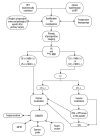Reoperations for persistent or recurrent primary hyperparathyroidism: results of a retrospective cohort study at a tertiary referral center
- PMID: 25201515
- PMCID: PMC4166223
- DOI: 10.12659/MSM.890983
Reoperations for persistent or recurrent primary hyperparathyroidism: results of a retrospective cohort study at a tertiary referral center
Abstract
Background: Parathyroid reoperations are challenging and achieving a cure requires multidisciplinary treatment team cooperation. The aims of this study were to summarize our experience in revision surgery for persistent (pHPT) or recurrent primary hyperparathyroidism (rHPT) and to explore factors underlying failure to cure at initial surgery.
Material and methods: This was a retrospective cohort study of patients who underwent reoperations for pHPT or rHPT at a tertiary referral center. The database of parathyroid surgery was searched for eligible patients (treated in the years 2000-2012). The primary outcome was the cure rate. All the patients were followed-up for at least 12 months postoperatively. Factors underlying failure to cure at initial surgery were reviewed based on hospital records.
Results: The study group comprised 88 patients (69 women, 19 men) operated on for persistent (n=57) or recurrent disease (n=31), who underwent 98 reoperations, including 26 (2.4%) patients first operated on at our institution, and 72 (81.8%) patients operated on elsewhere, but referred for revision surgery. A long-term cure was achieved in 83/88 patients (94.3%). The mean post-reoperation follow-up was 91.7 (12-176) months. Missed hyperfunctioning parathyroid gland was found on reoperation in eutopic position in 49 (55.5%) patients, and in ectopic position in 39 (44.3%) patients, including 20 (22.7%) cases of cervical ectopy and 19 (21.6%) cases of mediastinal ectopy.
Conclusions: Multidisciplinary treatment team cooperation at a tertiary referral center, consisting of an accurate preoperative localization, expertise in parathyroid re-explorations, and correct use of intraoperative adjuncts, contribute to the high success rate of parathyroid reoperations.
Figures

Similar articles
-
Reoperations for primary hyperparathyroidism--improvement of outcome over two decades.Langenbecks Arch Surg. 2013 Jan;398(1):99-106. doi: 10.1007/s00423-012-1004-y. Epub 2012 Sep 23. Langenbecks Arch Surg. 2013. PMID: 23001050
-
Reoperation for persistent or recurrent primary hyperparathyroidism.Langenbecks Arch Surg. 1998 Apr;383(2):174-9. doi: 10.1007/s004230050113. Langenbecks Arch Surg. 1998. PMID: 9641894
-
[The clinical analysis of preventable reoperation for primary hyperparathyroidism].Zhonghua Wai Ke Za Zhi. 2017 Aug 1;55(8):582-586. doi: 10.3760/cma.j.issn.0529-5815.2017.08.006. Zhonghua Wai Ke Za Zhi. 2017. PMID: 28789507 Chinese.
-
Reoperation for persistent or recurrent primary hyperparathyroidism.Arch Surg. 1996 Aug;131(8):861-7; discussion 867-9. doi: 10.1001/archsurg.1996.01430200071013. Arch Surg. 1996. PMID: 8712911 Review.
-
Approach to the patient with persistent or recurrent primary hyperparathyroidism.J Clin Endocrinol Metab. 2011 Oct;96(10):2950-8. doi: 10.1210/jc.2011-1010. J Clin Endocrinol Metab. 2011. PMID: 21976743 Review.
Cited by
-
Localisation of ectopic mediastinal parathyroid adenoma by 18F-fluorocholine PET/CT.BMJ Case Rep. 2018 Mar 28;2018:bcr2017222089. doi: 10.1136/bcr-2017-222089. BMJ Case Rep. 2018. PMID: 29592976 Free PMC article.
-
Etiology and Diagnosis of Permanent Hypoparathyroidism after Total Thyroidectomy.J Clin Med. 2021 Feb 2;10(3):543. doi: 10.3390/jcm10030543. J Clin Med. 2021. PMID: 33540657 Free PMC article. Review.
-
Update on the current management of persistent and recurrent primary hyperparathyroidism after parathyroidectomy.World J Clin Cases. 2023 Apr 6;11(10):2213-2225. doi: 10.12998/wjcc.v11.i10.2213. World J Clin Cases. 2023. PMID: 37122518 Free PMC article. Review.
-
Evaluation of diagnostic efficacy for localization of parathyroid adenoma in patients with primary hyperparathyroidism undergoing repeat surgery.Langenbecks Arch Surg. 2021 Aug;406(5):1615-1624. doi: 10.1007/s00423-021-02191-z. Epub 2021 May 16. Langenbecks Arch Surg. 2021. PMID: 33993327 Free PMC article.
-
[Intraoperative management of undetectable parathyroid adenoma].Chirurg. 2015 Jan;86(1):24-8. doi: 10.1007/s00104-014-2820-0. Chirurg. 2015. PMID: 25591414 Review. German.
References
-
- Henry JF. Reoperation for primary hyperparathyroidism: tips and tricks. Langenbecks Arch Surg. 2010;395:103–10. - PubMed
-
- Chen H, Wang T, Yen T, et al. Operative failures after parathyroidectomy for hyperparathyroidism: the influence of surgical volume. Ann Surg. 2010;252:691–95. - PubMed
-
- Mitchell J, Milas M, Barbosa G, et al. Avoidable reoperations for thyroid and parathyroid surgery: effect of hospital volume. Surgery. 2008;144:899–906. - PubMed
-
- Wells SA, Jr, Debenedetti MK, Doherty GM. Recurrent or persistent hyperparathyroidism. J Bone Miner Res. 2002;17(Suppl 2):N158–62. - PubMed
-
- Salmeron MD, Gonzales JM, Sancho-Insenser J, et al. Causes and treatment of recurrent hypoparathyroidism after subtotal parathyroidectomy in the presence of multiple endocrine neoplasia 1. World J Surg. 2010;34:1325–31. - PubMed
Publication types
MeSH terms
LinkOut - more resources
Full Text Sources
Other Literature Sources

